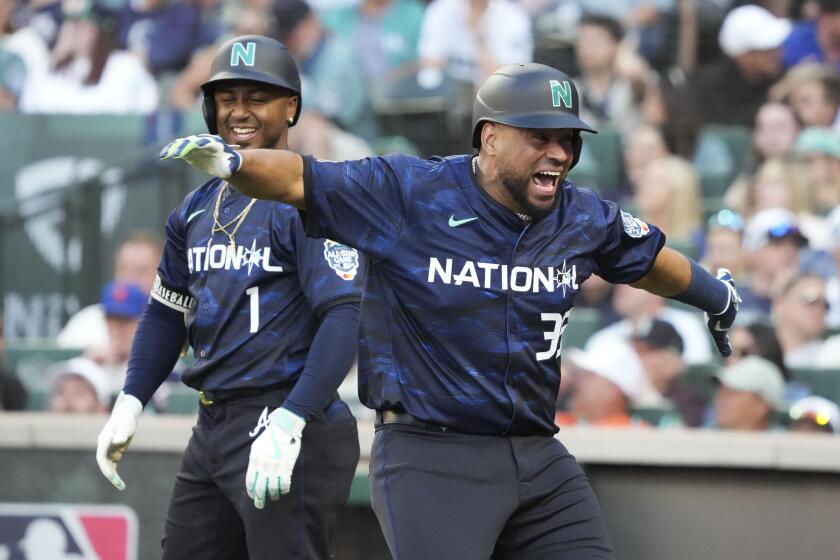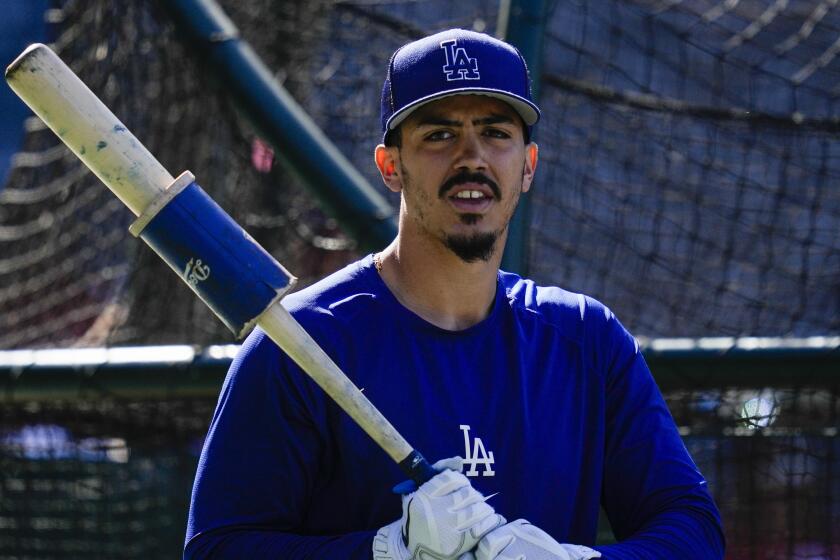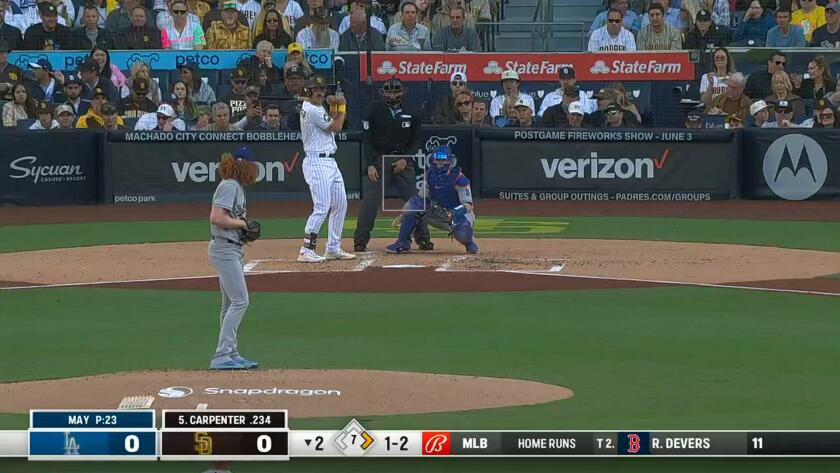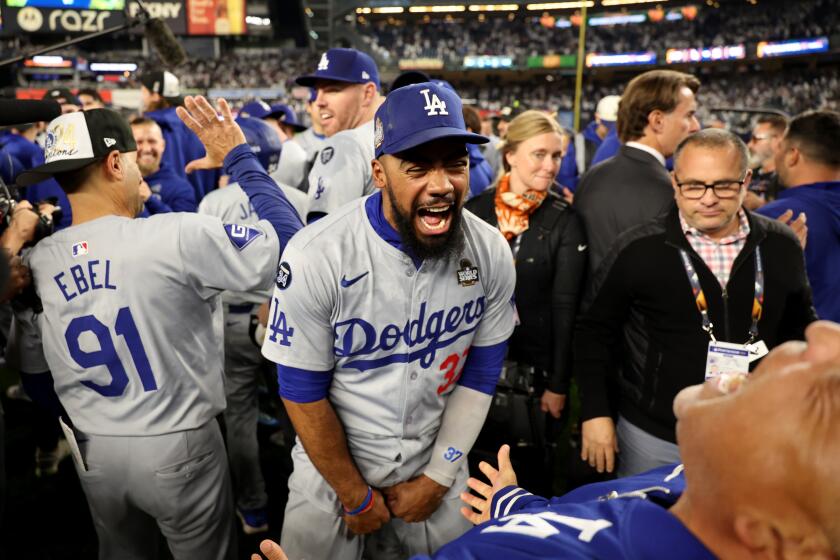Dodgers give Freddie Freeman high marks for his defense. So why do the computers say differently?
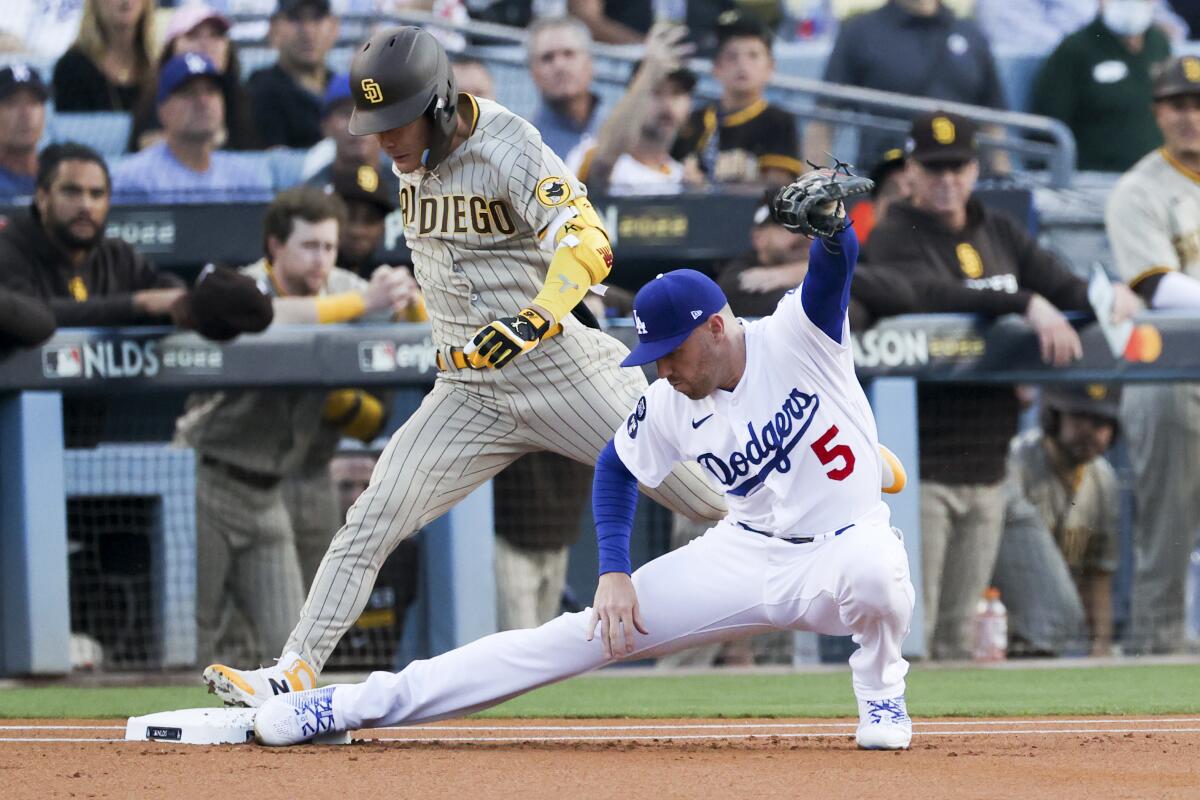
- Share via
Dodgers shortstop Miguel Rojas ranged deep into the hole for an Adolis García grounder last Friday night in Texas but knew as soon as he released his long throw across the diamond that the ball would bounce toward the right-field side of first base.
Rojas had no fear. Freddie Freeman was there.
Freeman has been the team’s most productive and consistent hitter this season with a .328 average, a National League-leading .989 on-base-plus-slugging percentage, 21 home runs, a major league-leading 35 doubles, 87 runs and 71 RBIs entering Friday night’s game against the Cincinnati Reds.
But the 13-year veteran has also played a pretty proficient first base, an underrated and somewhat overlooked aspect of his game that Freeman displayed again with his deft backhand scoop of Rojas’ one-hop throw against the Rangers, turning a potential error on the shortstop into a first-inning out.
“Knowing Freddie is there, you have the freedom of throwing the ball and just trying to make a play,” Rojas said. “I don’t have to worry about hitting him in the chest because I know his [pregame] work and routines are so solid, that if I bounce a throw, he’s got a pretty good chance of picking it.”
The NL defeated the AL in the All-Star Game, but it was the friendly antics between teammates and opponents that left the biggest mark.
Freeman, 33, started every one of the Dodgers’ 101 games through Wednesday and had not been charged with an error. He has a strong and accurate arm that he’s used to start 10 double plays, tied for second-most among first basemen behind Arizona’s Christian Walker (11) and Atlanta’s Matt Olson (11).
Thanks to a daily routine focusing on technique for catching one-hop throws — developed under Atlanta third-base coach Ron Washington and continued with Dodgers third-base coach Dino Ebel — Freeman has accumulated more “scoops” than any first baseman over the last five years, as measured by Sports Info Solutions’ throw-handling statistic.
“I’ve been around a lot of good first basemen, and the way his hands work, the way his feet work, his glove, his arm … he’s a plus defender for me,” Ebel said of the long and lanky Freeman, who is 6 feet 5 and 220 pounds. “As a coach, my eyes don’t lie.”
But do they tell the whole truth? Freeman gets rave reviews from his teammates and coaches, but there is no glove lost between Freeman and the computer programs that spit out the game’s advanced defensive metrics.
Entering Thursday, both Sports Info Solutions and Fangraphs ranked Freeman 17th among 20 qualifying first basemen with a minus-three defensive runs saved, a measure of how many runs better or worse a player is relative to the average player at his position.
Though Freeman’s 2.3 ultimate zone rating, which attempts to quantify how many runs a player saves or gives up through his fielding prowess, ranked second behind Walker’s, Freeman ranked 10th with 0 outs above average and 13th with a -6.6 overall defensive rating, which measures fielding runs saved relative to other positions.
“I know what kind of work I put in, I know what I do out there, and if the computer doesn’t like me, the computer doesn’t like me,” Freeman said. “But I would venture to say that my teammates and the coaches are going to say something different than what Fangraphs says, and that’s all I care about.”
Freeman won an NL Gold Glove Award with the Atlanta Braves in 2018 and was a finalist in 2021, so he clearly has the respect of his peers — the manager and six coaches from each team vote for the awards, which are also based, in part, on advanced metrics.
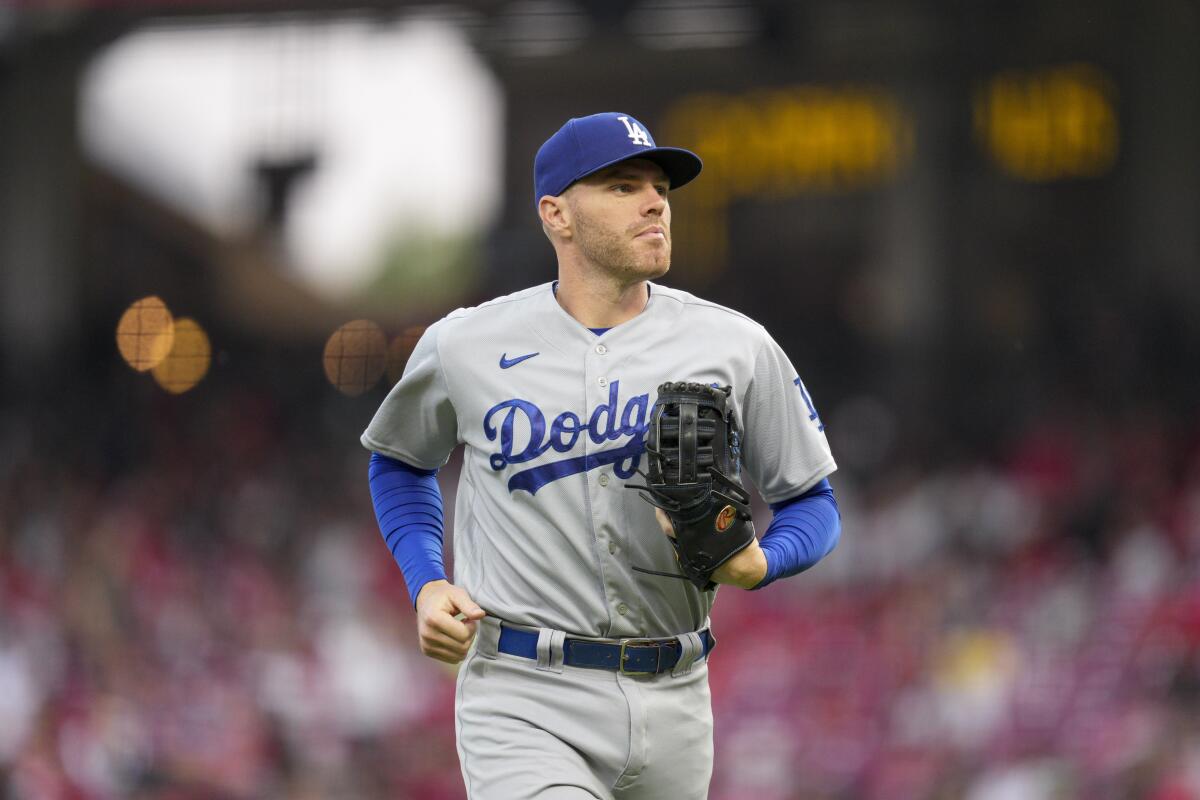
I know what kind of work I put in, I know what I do out there, and if the computer doesn’t like me, the computer doesn’t like me.
— Dodgers first baseman Freddie Freeman, on some of his advanced defensive metrics
The fact that Fangraphs and Sports Info Solutions consider Freeman a below-average defender is perplexing, but dig deeper into how those metrics are calculated, and some explanations begin to emerge.
The majority of a first baseman’s value comes in how well he turns batted balls into outs, relative to other first basemen, according to Mark Simon, lead baseball analyst for Sports Info Solutions. While his site puts a value on scooped throws, a Freeman forte, “we don’t put a lot of emphasis on it,” Simon said.
“We did some studies on this and came to the conclusion that most first basemen are very good at scooping throws, so the difference between the top and the middle of the pack isn’t great,” Simon added. “Freddie has rated well in the past and typically netted a couple of runs saved a year from it. This year, he’s at zero.”
Entering Thursday, there had been a major league-high 124 ground balls hit a distance of at least 60 feet to within about a 30-foot vicinity of the first-base line against the Dodgers. According to Sports Info Solutions, the Dodgers ranked 20th at turning those balls into outs, for a 77% conversion rate.
Conversion rates for such batted balls ranged from a high of 91% by the New York Mets to a low of 67% by the Oakland Athletics.
“I think a lot of that is positioning,” Freeman said. “Like, someone hit a cue shot toward the line in Baltimore [last week] and I was [playing toward the hole]. It’s a ball with like a 58-mph exit velocity and I can’t get there, so it’s like, well, that stinks.”
Freeman has been dinged this season on a few plays where he fielded grounders to his right, but the pitcher couldn’t get to the bag in time to receive his throw.
And rookie second baseman Miguel Vargas had so much trouble going to his left for the first two months of the season that several balls that could have and maybe should have been outs went into right field for hits, often resulting in penalties for both players.
The Dodgers optioned struggling rookie Miguel Vargas to triple A after he entered the All-Star break batting .195.
“If the system thinks it’s an easier catch for the first baseman to cut off the second baseman, even though he’s supposed to be covering the bag, he gets negative points if he doesn’t do it,” said Dodgers third baseman Max Muncy, who played first base in 2021. “Those can be manipulated based on where you’re playing.”
Sports Info Solutions also notes “defensive misplays,” tracking all mistakes in the field beyond typical fielding or throwing errors. Freeman had 11 misplays entering the week, so he’s on pace for a few more than the 14 he had last season.
Some examples:
- On May 6 in San Diego, Matt Carpenter hit a hard grounder to Freeman, who threw to second for a force out. Freeman got back to the bag but missed a low but catchable relay throw from Rojas. Freeman was not charged with an error because scorers can’t assume a double play, but it was a play that should have been made.
- Share via
-
- With runners on first and third and one out in a June 18 game in Dodger Stadium, San Francisco’s LaMonte Wade Jr. hit a grounder that Freeman got a glove on but couldn’t secure with a backhand stab. Freeman retrieved the carom and got the out at first, but he lost value because the run scored and another runner got to second.
- Share via
-
- On June 24 in Los Angeles, Houston’s Jose Altuve hit a low popup between first base and the mound. Freeman charged in and slid on both knees in his catch attempt, but the ball popped out of his mitt. The play was ruled a hit, but Statcast pegged the hit probability on the flare at just 2%, so Freeman’s defensive stats took a hit.
- Share via
-
“It’s a shame he gets docked a lot of points, but I think Freddie is an unbelievable first baseman,” Muncy said. “He can pick almost everything, and he’s so tall, it gives you a big comfort to know that if you just get the ball in his general area, he’s going to catch it.
“It eases your mind and makes your throw easier, whereas if you feel like you have to pinpoint your throw, then you start having a ton of bad throws because you’re trying to be so careful with it, and you don’t just let it go.”
Freeman takes pride in every aspect of his game, from hitting to defense to baserunning, “because I want to be the best baseball player, not the best hitter or power hitter,” he said.
It’s why he starts every day with defensive drills with Ebel in front of the dugout and why he takes ground balls at shortstop instead of first base, so he can keep his feet moving, maintain his arm strength and avoid becoming “a hockey goalie” at first base, where there is a tendency to just try to knock down balls and flip them to first base.
“My goal is to push off being a designated hitter as long as I possibly can, and as I’m getting older, I have to do more,” Freeman said. “I love being in the field. If you pick a ball and save an error, that fires up the guy who threw it, it fires up the pitcher, it can pump up your teammates.”
Freeman takes comfort in the fact that he is rated a plus defender by the Dodgers’ in-house analytics system, though general manager Brandon Gomes declined to say how many defensive runs Freeman has saved.
“There are a lot of eye tests in this game, a lot of numbers, and sometimes you gotta go with the eyes,” Freeman said. “I have not been told yet that my defense has been bad. If Fangraphs doesn’t like me, it doesn’t like me. All I care about is the Dodgers, and if they think I’m OK, that’s fine with me.”
More to Read
Are you a true-blue fan?
Get our Dodgers Dugout newsletter for insights, news and much more.
You may occasionally receive promotional content from the Los Angeles Times.

